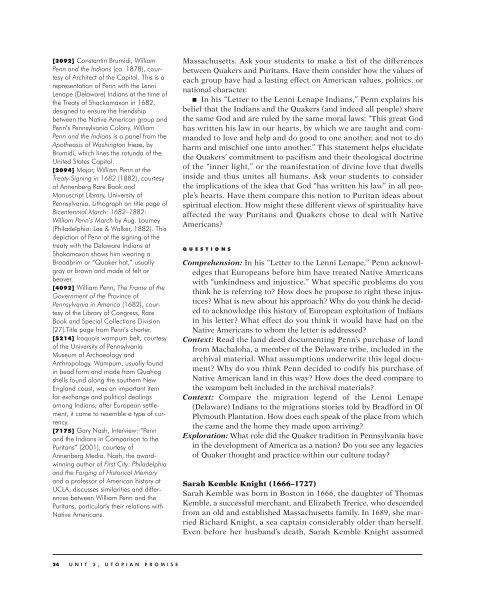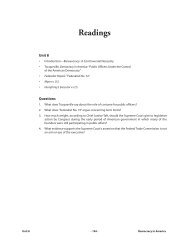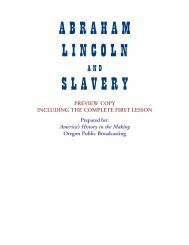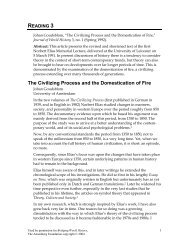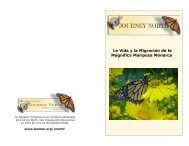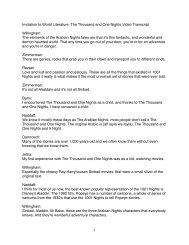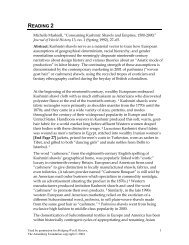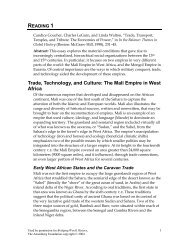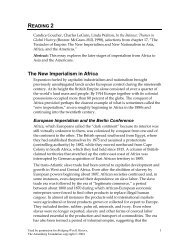UTOPIAN PROMISE - Annenberg Media
UTOPIAN PROMISE - Annenberg Media
UTOPIAN PROMISE - Annenberg Media
You also want an ePaper? Increase the reach of your titles
YUMPU automatically turns print PDFs into web optimized ePapers that Google loves.
[2092] Constantin Brumidi, William<br />
Penn and the Indians (ca. 1878), courtesy<br />
of Architect of the Capitol. This is a<br />
representation of Penn with the Lenni<br />
Lenape (Delaware) Indians at the time of<br />
the Treaty of Shackamaxon in 1682,<br />
designed to ensure the friendship<br />
between the Native American group and<br />
Penn’s Pennsylvania Colony. William<br />
Penn and the Indians is a panel from the<br />
Apotheosis of Washington frieze, by<br />
Brumidi, which lines the rotunda of the<br />
United States Capitol.<br />
[2094] Major, William Penn at the<br />
Treaty-Signing in 1682 (1882), courtesy<br />
of <strong>Annenberg</strong> Rare Book and<br />
Manuscript Library, University of<br />
Pennsylvania. Lithograph on title page of<br />
Bicentennial March: 1682–1882:<br />
William Penn’s March by Aug. Loumey<br />
(Philadelphia: Lee & Walker, 1882). This<br />
depiction of Penn at the signing of the<br />
treaty with the Delaware Indians at<br />
Shakamaxon shows him wearing a<br />
Broadbrim or “Quaker hat,” usually<br />
gray or brown and made of felt or<br />
beaver.<br />
[4092] William Penn, The Frame of the<br />
Government of the Province of<br />
Pennsylvania in America (1682), courtesy<br />
of the Library of Congress, Rare<br />
Book and Special Collections Division<br />
[27].Title page from Penn’s charter.<br />
[5214] Iroquois wampum belt, courtesy<br />
of the University of Pennsylvania<br />
Museum of Archaeology and<br />
Anthropology. Wampum, usually found<br />
in bead form and made from Quahog<br />
shells found along the southern New<br />
England coast, was an important item<br />
for exchange and political dealings<br />
among Indians; after European settlement,<br />
it came to resemble a type of currency.<br />
[7175] Gary Nash, Interview: “Penn<br />
and the Indians in Comparison to the<br />
Puritans” (2001), courtesy of<br />
<strong>Annenberg</strong> <strong>Media</strong>. Nash, the awardwinning<br />
author of First City: Philadelphia<br />
and the Forging of Historical Memory<br />
and a professor of American history at<br />
UCLA, discusses similarities and differences<br />
between William Penn and the<br />
Puritans, particularly their relations with<br />
Native Americans.<br />
24 UNIT 3, <strong>UTOPIAN</strong> <strong>PROMISE</strong><br />
Massachusetts. Ask your students to make a list of the differences<br />
between Quakers and Puritans. Have them consider how the values of<br />
each group have had a lasting effect on American values, politics, or<br />
national character.<br />
■ In his “Letter to the Lenni Lenape Indians,” Penn explains his<br />
belief that the Indians and the Quakers (and indeed all people) share<br />
the same God and are ruled by the same moral laws: “This great God<br />
has written his law in our hearts, by which we are taught and commanded<br />
to love and help and do good to one another, and not to do<br />
harm and mischief one unto another.” This statement helps elucidate<br />
the Quakers’ commitment to pacifism and their theological doctrine<br />
of the “inner light,” or the manifestation of divine love that dwells<br />
inside and thus unites all humans. Ask your students to consider<br />
the implications of the idea that God “has written his law” in all people’s<br />
hearts. Have them compare this notion to Puritan ideas about<br />
spiritual election. How might these different views of spirituality have<br />
affected the way Puritans and Quakers chose to deal with Native<br />
Americans?<br />
QUESTIONS<br />
Comprehension: In his “Letter to the Lenni Lenape,” Penn acknowledges<br />
that Europeans before him have treated Native Americans<br />
with “unkindness and injustice.” What specific problems do you<br />
think he is referring to? How does he propose to right these injustices?<br />
What is new about his approach? Why do you think he decided<br />
to acknowledge this history of European exploitation of Indians<br />
in his letter? What effect do you think it would have had on the<br />
Native Americans to whom the letter is addressed?<br />
Context: Read the land deed documenting Penn’s purchase of land<br />
from Machaloha, a member of the Delaware tribe, included in the<br />
archival material. What assumptions underwrite this legal document?<br />
Why do you think Penn decided to codify his purchase of<br />
Native American land in this way? How does the deed compare to<br />
the wampum belt included in the archival materials?<br />
Context: Compare the migration legend of the Lenni Lenape<br />
(Delaware) Indians to the migrations stories told by Bradford in Of<br />
Plymouth Plantation. How does each speak of the place from which<br />
the came and the home they made upon arriving?<br />
Exploration: What role did the Quaker tradition in Pennsylvania have<br />
in the development of America as a nation? Do you see any legacies<br />
of Quaker thought and practice within our culture today?<br />
Sarah Kemble Knight (1666–1727)<br />
Sarah Kemble was born in Boston in 1666, the daughter of Thomas<br />
Kemble, a successful merchant, and Elizabeth Trerice, who descended<br />
from an old and established Massachusetts family. In 1689, she married<br />
Richard Knight, a sea captain considerably older than herself.<br />
Even before her husband’s death, Sarah Kemble Knight assumed


